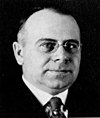Mr. Page introduced a scientific movement in roadbuilding that won enthusiastic national public support, He initiated “a petrographic study” of roadbuilding materials; wrote the first comprehensive report on the elements of roadbuilding rocks; and improved French rock-testing machines whereby physical tests of roadbuilding rocks became a routine procedure.
Thomas H. MacDonald 1919–1953

The good roads and highways Americans travel and enjoy today are a monument to Thomas H. MacDonald who for 34 years served as Chief of the Bureau of Public Roads and Commissioner of the Public Roads Administration.
Affectionately he was known as “Chief” by all who knew and worked with him.
When Chief MacDonald came to Washington in 1919, the office he was to head was still in its infancy. The Bureau had direct supervision over highway engineering activities and expenditures of Federal-aid funds.
The country had scarcely a quarter million miles of public roads when Chief MacDonald took office—and very little of that mileage was hard-surfaced. Few bridges were adequate to carry heavy truck traffic. Chief MacDonald in 34 years put together an integrated system of 3½ million miles of hard-surfaced highways which crisscrossed America.
Chief MacDonald personally directed the major steps in construction of the Alaska Highway. He also supervised fund expenditures to aid the countries of Central America in building the Inter-American Highway.
Francis V. du Pont 1953–1955

Francis V. duPont was connected with the development of highways in America since the early twenties.
He was appointed Commissioner of the Bureau of Public Roads in 1953 and while serving as Commissioner, advanced a highway program that led to legislation under which the Interstate Highway System was constructed.
Mr. duPont was the son of T. Coleman duPont who was the president of the giant chemical firm that bears that name in Wilmington, Delaware.
From 1922 through 1949, he was a member of the Delaware State Highway Commission. He also served as chairman of the Commission.
Mr. duPont played a major role in the development of the financing, engineering and the initial construction of the Delaware Memorial Bridge. When it was opened to traffic on July 1, 1951, it was the fifth longest suspension span in the world.
He had major accomplishments in the private, State and Federal sectors.
Mr. duPont resigned his Federal post on January 1, 1956. During his tenure as Commissioner, he was credited with stimulating interest in and getting the Interstate System underway.
192
